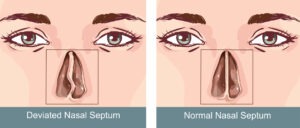The nasal septum is the thin wall of cartilage between the two nasal passages. Many people have a deviated septum, which is when the septum is displaced or off-center. This makes one nasal passage smaller than the other or can make both passages blocked, if the deviated septum is s-shaped.
Deviated septums are very common and have many different causes, including being present from birth. A nose injury is also a very common cause. If the nose is broken or injured, the septum can easily become displaced. Sometimes the natural aging process can change nasal structures, making a minor deviated septum worse.
Symptoms of a Deviated Septum

Many people don’t know they have a deviated septum, and they don’t experience any symptoms. For other people, however, the uneven nature of the nasal passages can cause the following signs:
- Difficulty breathing: With a deviated septum, one nasal passage may be narrowed or obstructed, making it difficult to breathe through the nostrils. This type of obstruction may be even more pronounced when you have an upper respiratory tract infection, like a cold, or allergies, which cause your nasal passages to swell.
- Nasal Congestion: Because the nasal passages are uneven, one side may accumulate more congestion than the other, or one side may feel completely stuffy or obstructed.
- Facial pain: A severe deviated septum could cause one-sided facial pain, tenderness, and pressure in the nose.
- Sinus pain and sinus infections: The sinuses are air-filled pockets in the face. A deviated septum may prevent proper drainage of mucus from the sinuses into the nasal cavity. When the natural sinus drainage process is obstructed, bacteria can grow in the sinuses, leading to infection and inflammation, and causing sinus pain and pressure.
- Nosebleeds: Because of turbulent airflow through a deviated septum, the nasal passages can become dry, which increases the chance of getting nosebleeds.
- Headaches: If air can’t flow freely, it can lead to feelings of stuffiness and built-up pressure, causing headaches.
- Dry Mouth: People with a deviated septum may find breathing through the nose difficult or unpleasant and so may instinctively breathe through the mouth more often, which can lead to a dry mouth and chapped lips.
- Snoring: Snoring and noisy breathing can be a sign of a deviated septum because of the narrowed passages and blocked or interrupted airflow.
- Tendency to sleep on a particular side: Oftentimes, people with a deviated septum don’t realize they have a tendency to sleep on one side over the other in order to optimize breathing through the less obstructed nasal passage.
Treatment for a Deviated Septum
Treatments for a deviated septum are relatively low risk. For many people the benefits of symptom relief far outweigh the risks.
If you experience frequent sinus infections (sinusitis) from a deviated septum, you may try nasal sprays and antibiotics to clear up the infection and manage symptoms, but these are short-term solutions and sinusitis may keep recurring if an untreated deviated septum is the cause. In fact, a deviated septum can become more severe as you age, so if you don’t address it, symptoms, including recurring sinus infections, may worsen over time.
The most effective way to treat a deviated septum is with a deviated septum repair procedure. When a deviated septum is repaired internally and functionally, it’s known as a septoplasty. When a septoplasty is combined with a cosmetic component, it’s known as a septorhinoplasty.
A septoplasty corrects the nasal septum deviation on the inside of your nose, straightening the septum so that nasal passages are even and allow proper airflow for improved breathing. Septoplasties, if mild, can be performed under local anesthesia, however more commonly they can be done as an outpatient procedure ion 30-45 minutes.
In a septoplasty, Dr. Cohen will make a very small incision inside the nose. The septum is corrected without breaking any nasal bones. After surgery, no cast is needed and most patients don’t experience external or visible bruising. Recovery is quick, with most patients returning to normal activities within a week.
When the procedure is purely functional, it is usually covered by most insurance companies to address a deviated septum for breathing problems. Nonetheless you may have a copay or deductible that will need to be taken care of. When a septorhinoplasty is used to reshape the deviated septum and to make cosmetic changes, insurance will often cover the functional part of the procedure which can be a cost-savings, however the cosmetic portions will be out of pocket.
A septorhinoplasty is a short outpatient procedure in which the surgeon makes small incisions inside the nostril, and sometimes across the base of the nose. Cartilage and inner bone are reshaped as desired. After rhinoplasty, a nasal splint is worn for about a week and most people experience some minor bruising and swelling around the nose for a few weeks.
Get Expert Help for a Deviated Septum
If you have the signs of a deviated septum, consult with an expert to find out how you can find relief from the discomfort. Deviated septum repair is possible with simple, minimally-invasive procedures. Dr. Alen Cohen, M.D., F.A.C.S. is highly regarded as the premiere provider of nasal and sinus care in Los Angeles at the Southern California Sinus Institute.
Contact us today for a consultation!

